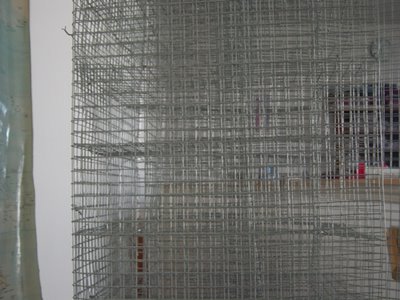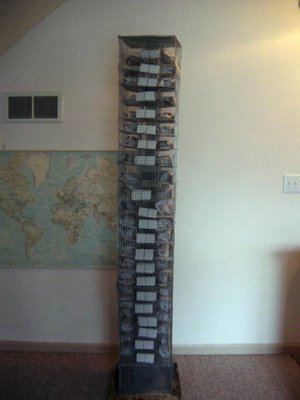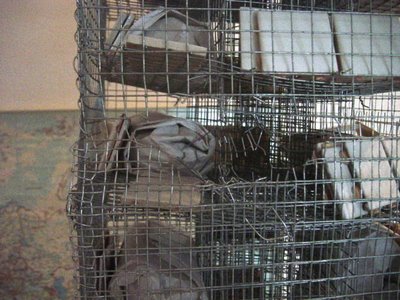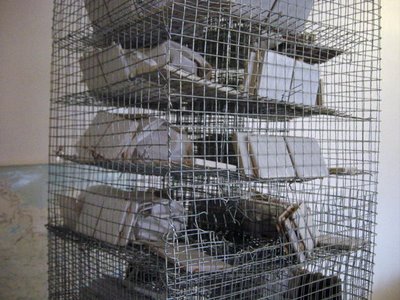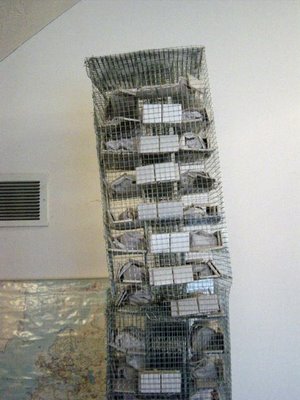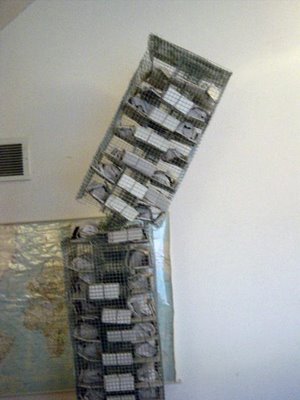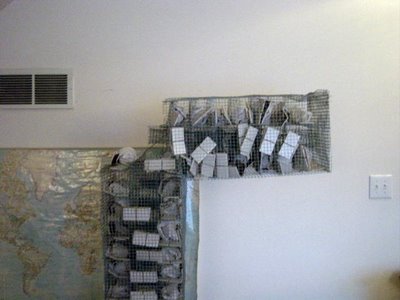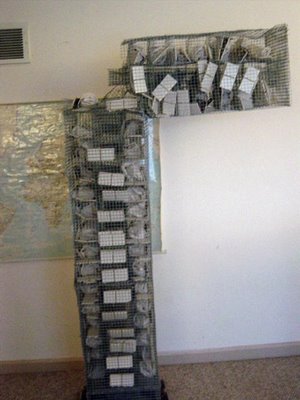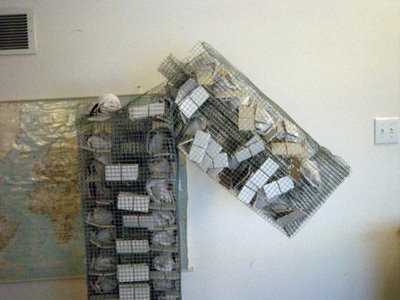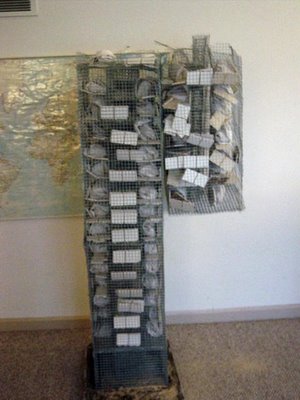Scaling, Euler's Formula and My WTC Model
I described and took pictures of my 1:200 scale WTC tower model here on thios blog.
I found that my model was extremely resistant to any sort of collapse.
If (admittedly a large "if") my model was an accurate representation of a WTC tower, my findings would strongly imply that the towers were blown up by demolition.
There were already many reasons to think the WTC was blown, but I built the model with hopes of creating a convincing physical case for demolition.
Importantly, I built the model in good faith. I didn't know what to expect, and if it had collapsed in a heap, I would have reported that. One reason to do experiments, after all, is TO LEARN.
The tower was built out of steel wire and was a 1/200th scale version of a WTC tower-- in terms of basic proportions. I knew it was not a perfect model and I never claimed it was a perfect representation of a WTC tower. I built it because I was interested in the collapse mechanics. In terms of scaling down, I tried to make things roughly proportional, such as weight and column strength.
I was in fact worried about scaling issues-- that idea that although the structural elements were proportionally smaller, that there would be a different degree of strength. But I wasn't sure how to control for that, and some limited research I did on scale models failed to reveal what I should be worried about.
So I proceeded with the model and you can see the results here.
Predictably, revealing my model here on my blog induced cries of derision from the usual suspects. What an idiot I was, what a moron I was, how sad I was, how pathetic I was, how sad if I passed my idiocy to my children, etc etc.
Unfortunately, there was very little in the way of productive criticism as to what was wrong with my model-- and in fact that was what I was looking for.
Yesterday, I noticed a new comment saying how dumb I was, how I should have taken an engineering course, then mentioning the strength of an ant relative to a man.
Putting aside the gratuitous insults, the ant strength idea was something I could grab onto, and I did a little bit of reading on the strength of ants versus men. According to one site (that I can't locate right now), the apparent strength of ants has mostly do with the relationship between strength and the cross-sectional area of muscles.
So that wasn't very useful. But the same site also noted how a man scaled up to 100 feet would not be able to stand, because his bones could not stand the weight-- even if they were proportionally bigger.
Now that sounded like something relevant to my model.
So I did some reading on column load versus length, and found Euler's formula. Most relevant to my model:
Another bit of information that may be gleaned from this equation is the effect of length upon critical load. For a given size column, doubling the unsupported length quarters the allowable load.
What this would mean in simple terms is a column gets progressively weaker as its length increases, even if it is proportionally stronger.
Thus, let us say you have a two inch column of thickness 1 (Column A). It can support load X without buckling.
Now, let us say you have an eight inch column (Column B) of thickness 4.
What load can it take? According to Euler's formula, very approximately, F = K/L^2
Where F = load force, K is a constant and L is length. Basically load is proportional to the inverse of the length squared.
For the two columns, the constants should basically cancel out. For column A, F= K/1 and for column B, F= K/16-- simply in terms of length. A column 4 times longer than another column of the same thickness would hold only 1/16th the weight or load.
But column B is 4 times thicker, making it in essence 4 times stronger. So it could roughly hold 1/4th the weight or load. Thus, VERY SIMPLY, a column that increases in size proportionally in terms of thickness and length will hold less weight by the factor that it increases in length.
Getting to my model now. It was a 1/200 scale, meaning the columns were 200 times stronger to the analogous WTC columns if they were perfectly proportional in terms of size and strength.
And this would then explain the scaling effect quite well-- why my model was so resistant to collapse.
But were my columns proportional?
In fact, my columns were not perfectly proportional. They were 1.9 times smaller proportionally than a WTC outer column, in terms of cross-section. And I used less of them per outer wall (24) than the WTC (62). So that lowers their effective strength by 2.6 fold. Another important consideration was that I had only 1/5th the floors of the WTC (22 versus 110), thus making my columns proportionally 5 times longer than WTC columns (though this is somewhat counter-balanced by the about same degree of horizontal cross-bracing as the WTC outer columns. So we can lower this length factor somewhat-- say 2-fold. This means my shorter model columns were approximately 20-fold stronger than the WTC columns (200/(1.9 x 2.6 x 2)) taking these factors into consideration.
Other factors are that:
a) the WTC columns were box columns whereas my model columns were solid thin wires (and a larger cross-sectional area hollow column is significantly stronger than a solid column with a smaller cross-sectional area)
b) the outer wall columns in my model had over 100 times less steel per cross-section than an individual WTC outer column (0.9 mm round) at floor 80 (180 sq. mm proportionally versus roughly 18320 sq. mm)
c) the galvanized steel wire in my model was undoubtedly poorer quality than the steel used to make WTC columns.
I will factor in that 100-fold cross-section and calculate that my individual model columns were at least 5-fold weaker than the WTC columns!
SO-- in fact, my model WAS indeed significantly weaker than the WTC and STILL DIDN'T COLLAPSE.
AGAIN, I CHALLENGE ANYONE TO BUILD A SCALE WTC MODEL THAT COLLAPSES UNDER ITS OWN WEIGHT.
P.S. Made a mistake in calculating cross-section of steel in the model columns and significantly revised the conclusions to this post a couple of hours after posting.
UPDATE 12/31/06: this section "b) the outer wall columns in my model had over 100 times less steel per cross-section than an individual WTC outer column (0.9 mm round) at floor 80 (180 sq. mm proportionally versus roughly 18320 sq. mm)" was wrong and thus my overall conclusions were very wrong.
I made a major error in calculations-- actually my model columns were 32400 sq. mm in proportional cross-section-- making them 1.8-fold stronger than WTC columns. This obviously changes the overall equation and means my model was roughly 34 times stronger proportionally than the WTC. Thus my model is not a good system for studying collapse mechanicS AND NEEDS TO BE REDESIGNED.
UPDATE 2-- 1/1/07-- OOPS again. Realized I factored in the scale of the columns twice, and the first time going the wrong way-- so I need to take away a factor of 1.9. Also found another mistake, meaning I need to redo the overall calculations.
So, my model columns were 200X stronger than the WTC columns due to scale.
They were 1.8x stronger proportionally, in terms of cross-section of steel.
I had 2.6x fewer columns per wall and 5x few floors meaning the effective strength of the model columns was 5x weaker. Except my model columns had similar cross-bracing to the WTC, meaning we need to lower the 5x figure. Let's be generous and cut this in half to 2.5x.
Thus we have 200 times 1.8 divided by 2.6 divided by 2.5 = 55.
Meaning that VERY ROUGHLY the model columns were 55 times stronger proportionally than the WTC columns. In reality the model is probably less than this-- due to weaker steel and inferior column shape. But the bottom line is the model is far too strong proportionally, and needs to be redesigned.
The simplest way would be to redo the model design with even smaller wires than what I used.


